人教版七年级英语下册第四单元教案
- 格式:doc
- 大小:739.84 KB
- 文档页数:28
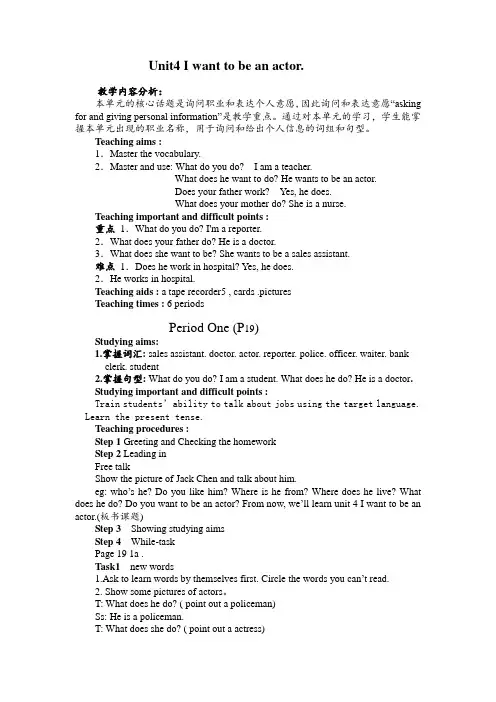
Unit4 I want to be an actor.教学内容分析:本单元的核心话题是询问职业和表达个人意愿,因此询问和表达意愿“asking for and giving personal information”是教学重点。
通过对本单元的学习,学生能掌握本单元出现的职业名称,用于询问和给出个人信息的词组和句型。
Teaching aims :1.Master the vocabulary.2.Master and use: What do you do? I am a teacher.What does he want to do? He wants to be an actor.Does your father work? Yes, he does.What does your mother do? She is a nurse.Teaching important and difficult points :重点1.What do you do? I'm a reporter.2.What does your father do? He is a doctor.3.What does she want to be? She wants to be a sales assistant.难点1.Does he work in hospital? Yes, he does.2.He works in hospital.Teaching aids : a tape recorder5 , cards .picturesTeaching times : 6 periodsPeriod One (P19)Studying aims:1.掌握词汇: sales assistant. doctor. actor. reporter. police. officer. waiter. bankclerk. student2.掌握句型: What do you do? I am a student. What does he do? He is a doctor.Studying important and difficult points :Train students’ability to talk about job s using the target language. Learn the present tense.Teaching procedures :Step 1 Greeting and Checking the homeworkStep 2 Leading inFree talkShow the picture of Jack Chen and talk about him.eg: who’s he? Do you like him? Where is he from? Where does he live? What does he do? Do you want to be an actor? From now, we’ll learn unit 4 I want to be an actor.(板书课题)Step 3Showing studying aimsStep 4While-taskPage 19 1a .Task1 new words1.Ask to learn words by themselves first. Circle the words you can’t read.2. Show some pictures of actors。

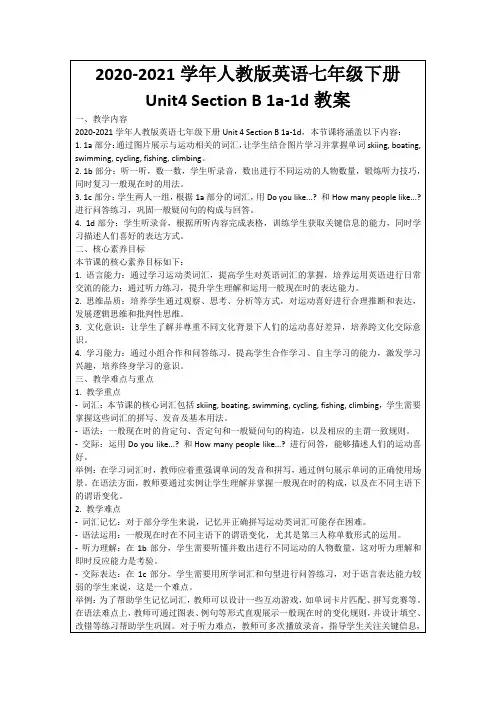

Unit 4 Don’t eat in class.SectionB (1a-2c)知识目标:熟练掌握重点词汇以及重点句型:dirty, kitchen, more, noisy,make one’s bed, be strict with sb. follow the rulesThere are too many rules …I can…; I can’t…;I must…; I have to …; I…技能目标:1.能根据文章特点和活动要求使用寻读策略。
2. 能和朋友谈论校规和家规。
情感目标:能读懂一些英语的规则制度,能用英语表达和制定一些简单的规则,理解没有规矩不成方圆;无论是在学校时还是在家庭中以及以后走上社会都应当遵守规则,按规则办事。
1. 教学重点:1) 学习本课时出现的新词汇及表达方式。
2) 通过进行听力训练,让学生们能听懂本节课时所出现的新的表达方式。
3) 通过进行阅读练习来进一步学习运用本课时的新语言知识。
2. 教学难点1)阅读训练。
2)理解must, have to/ can/can't的用法三、学习过程Ⅰ. Warming- up and revision1. Greet the Ss.2. Check the homework. Let some Ss read their home rules.3.通过图片提问Do you know these signs in a city?What do they mean?4.再通过运用思维导图进行引导How many rules do you know?Ⅱ. Presentation1. Show some pictures on the big screen and let Ss learn the new words and expressions.2. 学生看着1a部分的图片___ go out___ see friends___ do his homework___ practice the guitar___ do the dishes___ watch TV___ help his mom make breakfast___ clean his room进行FREE TALKWhat can you do at home ?What can’t you do ?Can you go out on school nights?Ss: No, we can’t.T: Yes, in China, the students can’t go out on school nights.So please don’t go out on school nights.Ⅲ. Listening1. Tell Ss they'll listen to the recording about Dave's house rules. Listen and put an× for things Dave can't do and a √for things he has to do.2. Play the recording for the Ss to listen and check.3. Play the recording again for the Ss to check the answers.Ⅳ. Listening1. Now let's work on 1c. Now first, let's read the phrases aloud together.help his mom makebreakfastclean his roomWhat are the rules at your home?Can you go out on school nights?Do you have to do your homework first?Lead-inWhen you are unhappy about something, who do you like to talk to ?Task 1.Skimming (速读--默读)1. What’s Molly’s problem?2. Does she have rules in school?3. What does Molly think of the rules?Read 2b quickly and find the main idea. The main idea of the two letters is that___. A: there are many rules for MollyB: Dr. Know wants to help MollyC: Molly asks Dr. Know for some help and Dr. Know gives her some help.Task2. ScanningRead the letters again and complete the timeline (再读信,并且完成时间轴. )Task3.Detailed readingA).Read the first paragraph and fill in the blanks.B)Read the second paragraph and fill the rule made by her dad.C) Dr. Know's advice: We have to _____________.观察与思考求助信的写作格式:1)2)3)2c Read the letters again. Complete the sentences with have to/must, can or can’t.1. Molly _____ play basketball on school days, but she ____ play it on weekends.2. Molly _____ do her homework first when she gets home.3. Molly _____ read a book after dinner before she _____ watch TV.4. At school, Molly ____ be noisy or eat in class.5. Parents and schools make rules to help students. So students ______ follow the rules.Group worke.g.:At school/home/the library, we have to(must) ...We can't...(巩固)Language points1. _________ the guitar 练习吉他practice v.意为“练习”后面可跟名词、代词或动名词。
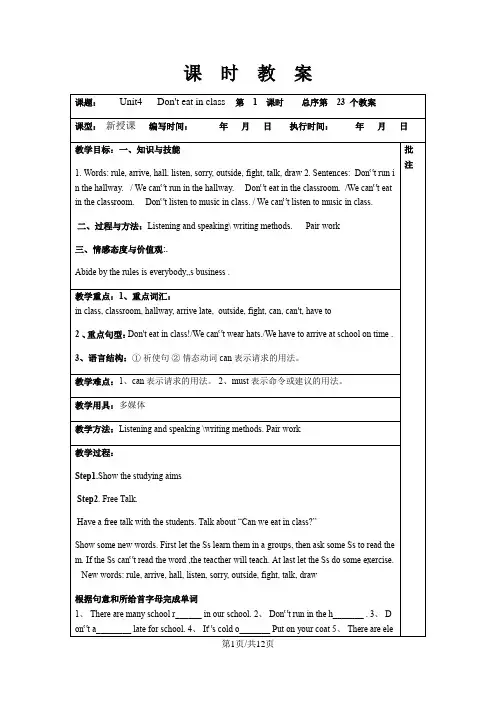
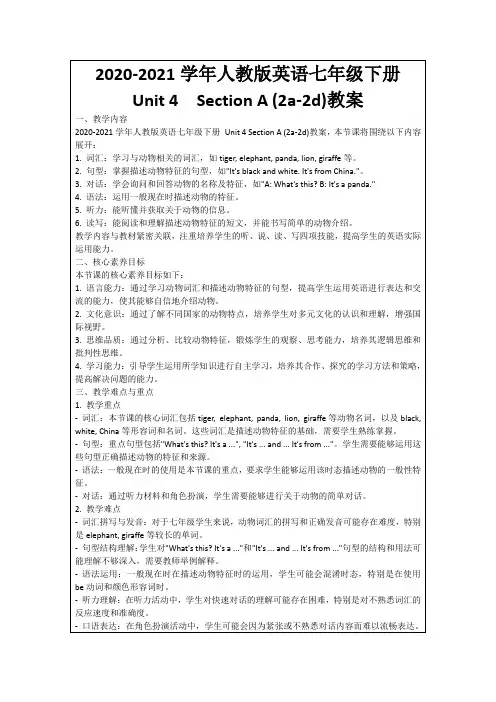
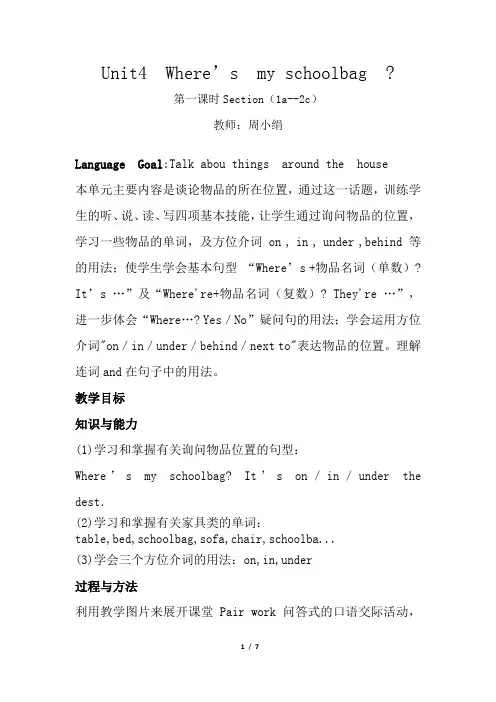
Unit4 Where’s my schoolbag ?第一课时Section(1a--2c)教师:周小绢Language Goal:Talk abou things around the house本单元主要内容是谈论物品的所在位置,通过这一话题,训练学生的听、说、读、写四项基本技能,让学生通过询问物品的位置,学习一些物品的单词,及方位介词 on , in , under ,behind 等的用法;使学生学会基本句型“Where’s +物品名词(单数)? It’s …”及“Where're+物品名词(复数)? They're …”,进一步体会“Where…? Yes/No”疑问句的用法;学会运用方位介词"on/in/under/behind/next to"表达物品的位置。
理解连词and在句子中的用法。
教学目标知识与能力(1)学习和掌握有关询问物品位置的句型:Where’s my schoolbag? It’s on/in/under the dest.(2)学习和掌握有关家具类的单词:table,bed,schoolbag,sofa,chair,schoolba...(3)学会三个方位介词的用法:on,in,under过程与方法利用教学图片来展开课堂Pair work 问答式的口语交际活动,使学生学会基本句型“Where’s my schoolbag ? ”It’s under the chair.及方位介词情感态度价值观这部分学习内容贴近学生的生活,谈论的主题是学生最关心的问题,促使学生了解自己的家居环境,热爱自己的家。
教学重点(1)方位介词:in, on,under的用法;(2).Where的特殊疑问句(3)新单词:chair,bed,table,bookcase,radio,sofa,head... 教学难点1)能够准确运用方位介词描述物品所在的位置;2)能够运用Where问句找到物品的位置。
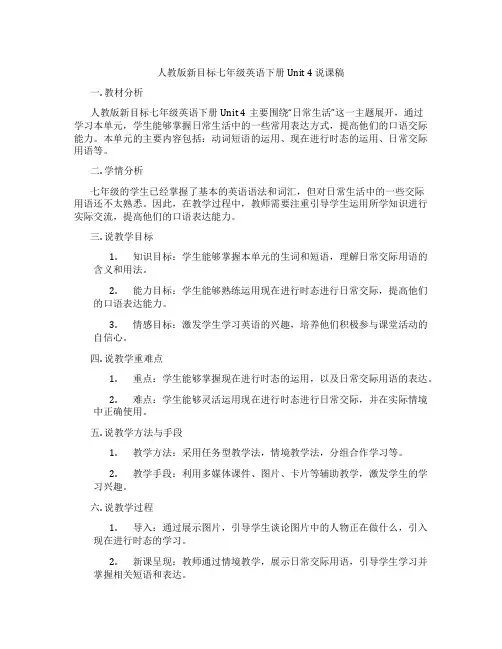
人教版新目标七年级英语下册 Unit 4 说课稿一. 教材分析人教版新目标七年级英语下册Unit 4主要围绕“日常生活”这一主题展开,通过学习本单元,学生能够掌握日常生活中的一些常用表达方式,提高他们的口语交际能力。
本单元的主要内容包括:动词短语的运用、现在进行时态的运用、日常交际用语等。
二. 学情分析七年级的学生已经掌握了基本的英语语法和词汇,但对日常生活中的一些交际用语还不太熟悉。
因此,在教学过程中,教师需要注重引导学生运用所学知识进行实际交流,提高他们的口语表达能力。
三. 说教学目标1.知识目标:学生能够掌握本单元的生词和短语,理解日常交际用语的含义和用法。
2.能力目标:学生能够熟练运用现在进行时态进行日常交际,提高他们的口语表达能力。
3.情感目标:激发学生学习英语的兴趣,培养他们积极参与课堂活动的自信心。
四. 说教学重难点1.重点:学生能够掌握现在进行时态的运用,以及日常交际用语的表达。
2.难点:学生能够灵活运用现在进行时态进行日常交际,并在实际情境中正确使用。
五. 说教学方法与手段1.教学方法:采用任务型教学法,情境教学法,分组合作学习等。
2.教学手段:利用多媒体课件、图片、卡片等辅助教学,激发学生的学习兴趣。
六. 说教学过程1.导入:通过展示图片,引导学生谈论图片中的人物正在做什么,引入现在进行时态的学习。
2.新课呈现:教师通过情境教学,展示日常交际用语,引导学生学习并掌握相关短语和表达。
3.课堂练习:学生分组进行角色扮演,运用所学知识进行实际交流,教师给予指导和反馈。
4.巩固环节:学生进行听力练习,观看相关情景对话,理解并运用日常交际用语。
5.拓展环节:学生进行小组讨论,创造性地运用所学知识,创作自己的日常交际对话。
6.总结:教师对本节课的主要内容进行总结,强调现在进行时态的运用和日常交际用语的重要性。
七. 说板书设计板书设计要简洁明了,突出重点。
主要包括现在进行时态的构成、日常交际用语的表达等。
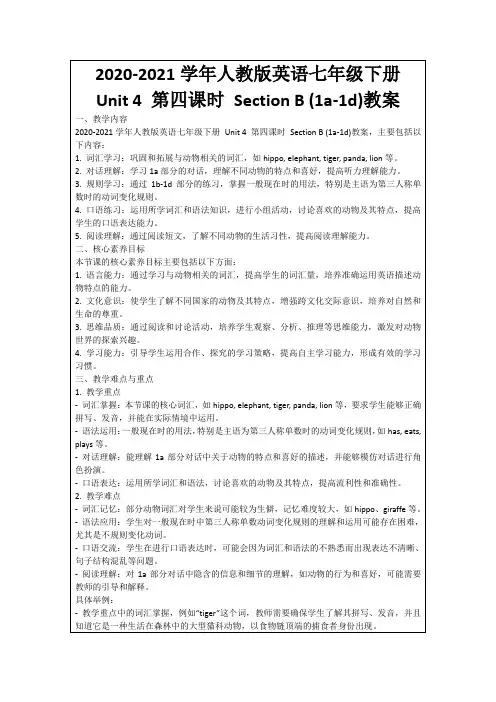
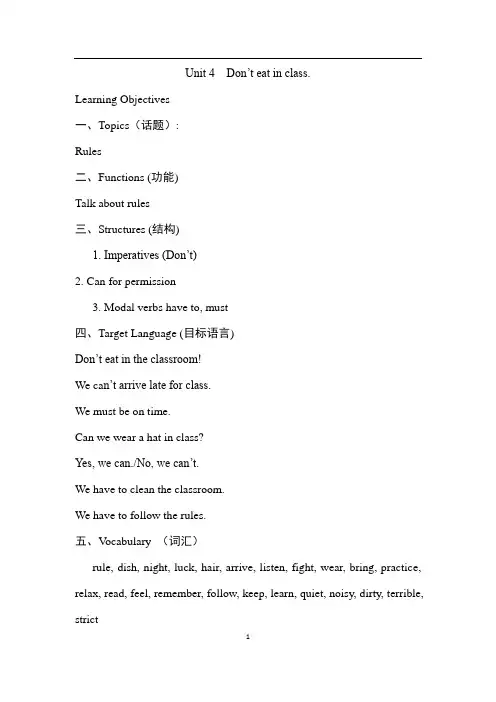
Unit 4 Don’t eat in class.Learning Objectives一、Topics(话题):Rules二、Functions (功能)Talk about rules三、Structures (结构)1. Imperatives (Don’t)2. Can for permission3. Modal verbs have to, must四、Target Language (目标语言)Don’t eat in the classroom!We ca n’t arrive late for class.We must be on time.Can we wear a hat in class?Yes, we can./No, we can’t.We have to clean the classroom.We have to follow the rules.五、V ocabulary (词汇)rule, dish, night, luck, hair, arrive, listen, fight, wear, bring, practice, relax, read, feel, remember, follow, keep, learn, quiet, noisy, dirty, terrible, strictarrive late for class, be on time, listen to music, do the dishes, make your bed, be strict with …, follow the rules六、Skills (技能)Listening for key informationScanning in reading七、Recycling (复习巩固)go out, do your homework, watch TV, clean your room, help your mom make breakfast, in the evening, every Saturday八、教材分析这本教材的词汇量很大,有难度,但是,内容新颖,尤其是生动活泼的卡通化的画面,很符合七年级学生的年龄特点和心理特点,其中还囊括了丰富多彩的文化知识,以及合作探究的活动,十分贴近学生的实际生活经验。
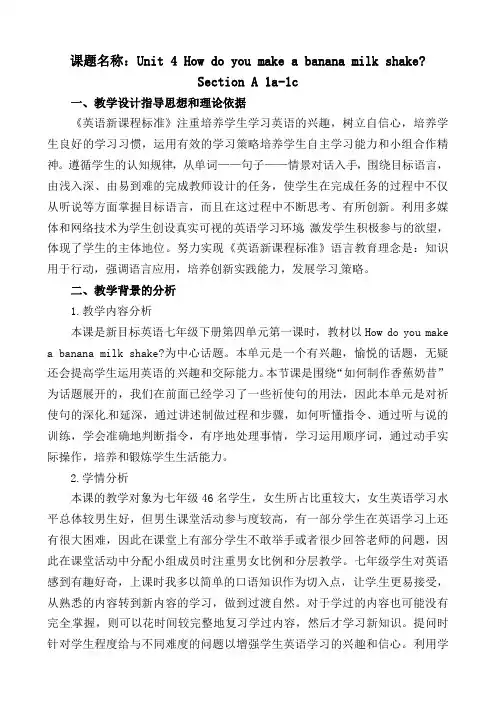
课题名称:Unit 4 How do you make a banana milk shake?Section A 1a-1c一、教学设计指导思想和理论依据《英语新课程标准》注重培养学生学习英语的兴趣,树立自信心,培养学生良好的学习习惯,运用有效的学习策略培养学生自主学习能力和小组合作精神。
遵循学生的认知规律,从单词——句子——情景对话入手,围绕目标语言,由浅入深、由易到难的完成教师设计的任务,使学生在完成任务的过程中不仅从听说等方面掌握目标语言,而且在这过程中不断思考、有所创新。
利用多媒体和网络技术为学生创设真实可视的英语学习环境,激发学生积极参与的欲望,体现了学生的主体地位。
努力实现《英语新课程标准》语言教育理念是:知识用于行动,强调语言应用,培养创新实践能力,发展学习策略。
二、教学背景的分析1.教学内容分析本课是新目标英语七年级下册第四单元第一课时,教材以How do you make a banana milk shake?为中心话题。
本单元是一个有兴趣,愉悦的话题,无疑还会提高学生运用英语的兴趣和交际能力。
本节课是围绕“如何制作香蕉奶昔”为话题展开的,我们在前面已经学习了一些祈使句的用法,因此本单元是对祈使句的深化和延深,通过讲述制做过程和步骤,如何听懂指令、通过听与说的训练,学会准确地判断指令,有序地处理事情,学习运用顺序词,通过动手实际操作,培养和锻炼学生生活能力。
2.学情分析本课的教学对象为七年级46名学生,女生所占比重较大,女生英语学习水平总体较男生好,但男生课堂活动参与度较高,有一部分学生在英语学习上还有很大困难,因此在课堂上有部分学生不敢举手或者很少回答老师的问题,因此在课堂活动中分配小组成员时注重男女比例和分层教学。
七年级学生对英语感到有趣好奇,上课时我多以简单的口语知识作为切入点,让学生更易接受,从熟悉的内容转到新内容的学习,做到过渡自然。
对于学过的内容也可能没有完全掌握,则可以花时间较完整地复习学过内容,然后才学习新知识。
UNIT 4Don ’teat in class.Section A第1课时(1a~1c)自主学习方案1.自学生词,并记着拼读及拼写。
2.预习课本找出要点短语及句子。
(见教案自学导练内容)3.读记后达成自学导练内容。
讲堂导学方案Step 1 情形导入Show the students the picture of fighting.T:Look at the two boys. What are they doing?Ss:(Help Ss) :They are fighting.T : Can we fight?Ss:No,we can't.T : What should we say to the boys?Ss:We should say to them: Don't fight.环节说明:经过师生对话引出新知识—祈使句。
Step 2 达成教材 1a_1c 的任务1.学习 la 中的学校规定,高声朗诵这些规定,而后将这些规定的序号填在相对应的人物旁边。
(3 分钟)2.认真听录音,找出Peter, Amy 和 Mike 违犯了哪些规定,在lb 中的横线上写出la中的数字,师生共同查对答案。
(2 分钟)3.再听一遍录音,同时跟读。
(2 分钟)4.练习 lc 中的对话。
而后编写新对话,小组内进行对话练习,并进行组与组之间的比赛,教师评论。
(5 分钟)5.小结训练。
(3 分钟)把以下祈使句改成否认形式。
(1)Eat in the hall.(2)Talk loudly.Don't eat in the hall. Don't talk loudly.环节说明:听闻联合,第一时间向学生传达语言目标,经过结对对话练习和小结训练,学生能够娴熟掌握祈使句。
Step3 问题研究1.arrive 的用法用arrive,arrive in/at 填空。
(1)When do you arrive in Shanghai every week?(2)When I arrive at Yucai Middle School in Shanghai,it is 7:50.(3)After I arrive here, I begin my class.【注意】 arrive“抵达”,arrive 是一个不及物动词,不可以直接跟表示地址的名词。
Unit 4 : Don’t eat in class一.考点、热点回顾【重点单词】规则,规章__________ 到达____________ 带来,取来__________ 安静的_______________ 在…以前______________更多______________ 吵闹的______________ 感受,觉得___________ 严格的,严厉的______________ 记住,记起__________________ 幸运,运气___________ 保持,保留__________________【重点短语】上学迟到_____________ 按时__________ 听____________ 上课迟到_____________不得不______________ 太多____________ 好运_____________玩的开心_____________想让某人做某事__________________ 每天______________【重点句型】1.上课不到迟到__________ ___________ __________ for class.2.你必须准时You _____________ ____________ ____________ ____________.3.在课堂上不要听音乐__________ _________ __________ music in class.4.我们能把音乐播放器带到学校来吗?_________ we __________ music players ___________ school ?5.我们不必每天都来上学We don’t ___________ __________ come to school __________ __________.6.规则太多There are ___________ ______________ rules.7….我不想让猫抓住我… I don’t ____________ the cat __________ __________ me.【重点语法】【祈使句】祈使句是用来表示命令,请求或建议的一种句型。
第4课时Section B(2a-Self Check) 【学习目标】【课堂导学】Step 1 情景导入Teacher:When you are unhappy about something,who do you like to talk to,your parents,your teachers or your friends?Can you tell me?Students:…Teacher:Molly is a student like us. She is very upset. Do you know why she is unhappy,and who she likes to talk to?环节说明:通过情景导入既完成了2a的学习又引出了Molly的烦恼,引起学生的好奇心,激发了他们的学习欲望。
Step 2 完成教材2a~2c的任务1.小组内讨论2a的问题。
2.快速阅读2b信件了解信件内容,圈出Molly 的家规。
(2分钟)3.再次认真阅读信件,回答下列问题。
(3分钟)(1)Are there many rules at Molly's home?(2)How does Molly go to school?(3)Does Molly never play basketball?4.第三遍阅读短文完成2c的选词填空。
(3分钟)5.小结训练。
(4分钟)单项选择。
(1)Please don't make so much__A__.It's too______.A.noise;noisy B.noisy;noisy C.noise;noise D.noisy;noise(2)Mr. Zhang is our English teacher,and he is very strict__C____us and__________his work.A.in;in B.with;with C.with;in D.in;with(3)__B__he________I can go there by bike because there is only one bike.A.Between;and B.Either;or C.Neither;or D.Either;and环节说明:这一环节的学习不仅巩固了本单元的语法,而且还锻炼了学生阅读能力和概括能力。
Unit 4 Don't eat in class.Section A (1a-2d)一、教学目标:1. 语言知识目标:1) 能掌握以下单词:rules, arrive, late, hall, dinning hall, listen, listen to, fight, sorry2) 能掌握以下句型:①Don't eat in class.②You must be on time.③Eat in the dining hall.2. 学会用英语表达一些标志的含义。
3. 熟练使用目标语言谈论对某些规章制度(校规、家规等)的看法3. 情感态度价值观目标:能用英语表达和制定一些简单的规则,理解没有规矩不成方圆;无论是在学校时还是在家庭中以及以后走上社会都应当遵守规则,按规则办事。
二、教学重难点1. 教学重点:1) 肯定祈使句是省略掉主语的原形动词开头;2) 否定祈使句则是在肯定祈使句前加上“don’t”。
3) 情态动词must及have to在用法上的区别。
2. 教学难点:掌握祈使句的用法,并能听懂、会说一些简单的祈使句。
三、教学过程Ⅰ. Warming-up and revision教师进教室后,使用祈使句请学生们完成一系列动作:Please stand up/ sit down. Close the door, please. Look at me and listen to me.Don’t open your books. Don’t talk. Let’s begin our class.学生听教师的指令完成各种动作,教师也可将指令写到黑板上,让学生从视觉上考察祈使句的特点。
Ⅱ. Presentation教师出示书上1a 的图片,向学生提问。
指着图上奔跑的男孩提问T:What’s the boy doing? S: He’s running.T: Where is he running? S: He’s running in the hallways.(板书,教读)T:Can you run in the hallways? S: No, I can’t.T: So please don’t run in the hallways.(板书,教读)(= You can’t run in the hallways.)学生跟读数遍,明白祈使句和“can”的表达含意。
T:Why is he running in the hallways? S: He’s late.T: Oh, he’s late for class.(板书,教读)You can’t arrive late for class.(板书,教书) = Don’t arrive late for class.…Ⅲ. 1aT: Now, Look at the picture on your textbook. Each of the students is breaking one of these rules.Please finish 1a.学生看图,完成1a的内容,检查答案并大声朗读校规。
Ⅳ. Listening1. T: Now let’s listen! What rules are these students breaking? Write the numbers after names?2. 学生们听录音,完成1b,选出四位学生都违反了哪条校规;听之前,学生要读会英文名。
3. Check the answers:Ⅴ. Pair work请两位学生朗读1c部分的句型;要求学生两人一组对话表演,SA扮演外校转来新生,SB告知本校校规。
(学生可经过讨论,多说出他们想到的校规,不必只限于书上;教师应给予帮助)Ⅵ. Listening1. Work on 2a:First, let's read the sentences in 2a together.T: Now, let's listen to the recording. Check the activities Alan and Cindy talk about.Ss listen to the recording and check the activities they hear.Play the recording again for the Ss to check the answers.2. Work on 2b:Make Sure Ss know what they should do.Listen to the recording again. Can Alan and Cindy do these activities? Circle can or can't above.3. Check the answers:Ⅶ. Pair work1. Suppose you are Alan and your partner is Cindy. Talk about the rules in 2a.2. Let some students come to the front and act out the conversations.Ⅷ. Role-play1. Read the conversation and find some rules in this school?2. Ss read the conversations and find the answers to this question.3. Check the answers:( Don't be late for school. Don't bring music players to school. You always have to wear the school uniform. You have to be quiet in the library. )Homework:1. Remember the new words and expressions.2. 完成下列句型转换试题1)I can play computer games on weekends.(一般疑问句)_________________________________? Yes, ____________.2)He has to wear uniform.(变否定句)He _____ _____ _____ wear uniform.3)I have to wear sneakers for gym class.(一般疑问句)_____ you ____ ____ wear sneakers for gym class? Yes, I ____.4)They have to wash clothes.(提问)____ do they have ____ ____?5)You can’t go out on school nights.(换一种表达)_______ go out on school nights.6)Don’t talk in class.(同上)No _________.板书设计:Section A (Grammar Focus-3c)一、教学目标:1. 语言知识目标:1) 继续练习运用如何做自我介绍及问候他人。
学会从对话中获取对方的基本信息(询问他人姓名)。
能掌握以下句型:①Don't eat in class.②You must be on time.③Eat in the dining hall.2. 情感态度价值观目标:该部分继续学习使用目标语言谈论对某些规章制度(校规、家规等)的看法。
二、教学重难点1. 教学重点:1) 继续学习使用目标语言谈论对某些规章制度(校规、家规等)的看法2) 通过不同方式的练习方式来学会用英语表达一些标志的含义。
3) 运用祈使句来表达一些规章和制度。
2. 教学难点:1) 总结用祈使句、情态动词can、must及have to来表达各种规章制度;2) 能用所学的知识来制定一些简单的规章制度。
三、教学过程Ⅰ. Warming- up and revision1. Greet the Ss as usual.2. Check the homework.Ⅱ. Grammar Focus.1. 学生阅读Grammar Focus中的句子,然后做填空练习。
①不要在楼道里跑。
_______________________②不要打架。
____________________③有什么规则?___________________④我们必须按时上课。
____________________⑤我们可以在教室里吃东西吗?____________________⑥不能。
但我们可以在餐厅里吃东西。
___________________⑦我们可以在教室里带帽子吗?____________________…2. Ss finish off the sentences and check the answers by themselves.3. Give eight more minutes for the Ss to remember the sentences.Ⅲ. Writing1. Look at 3a. Do you know the meaning of these pictures? Yeah, you see them in the school library. Can you write the rules for the school library?2. Ss discuss the pictures and make some rules.3. Let some Ss read their rules aloud.4. Check the answers with the class.(Don't listen to music in the library. Don't eat or drink in the library. Don't take photos in the library. )Ⅳ. PracticeWork on 3b:1. T: Use the words to make questions about the rules. Then write answers according to your school. For example: Be quiet? (she/have to/ in the library)Does she have to be quiet in the library?Yes, she does.2. 注意:have to虽是情态动词,但其在句子中与谓语动词共同构成句子时,其一般疑问句应用助动词do或does 来帮助构成;而情态动词can则直接提前构成一般疑问句式。